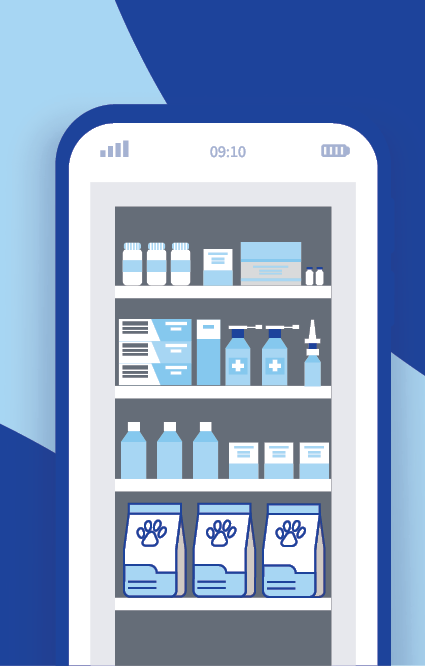

It is important to fully integrate retail e-commerce into the hospital strategy and to market it accordingly.
by Lowell Ackerman, DVM, DACVD, MBA, MPA, CVA, MRCVS
E-commerce is a broad term for selling products or services over the internet and executing those transactions online. In the past, this often meant just selling products online, but we are now experiencing a new set of circumstances where services are also increasingly being transacted over the internet. Are you ready?
Retail Sales
In many small-animal veterinary practices, the dispensing of medications, diets, and nonprescription products (including many parasite-control products) is the largest revenue center by far. This can be deceptive when we think about the day-to-day activities of taking care of pets and their owners, but dispensing accounts for about one-quarter of all revenue in a typical companion-animal veterinary hospital. It can therefore be troubling when we contemplate the competition we face for such sales, such as from online retailers, big-box stores, and even retail-anchored veterinary practices.
To be competitive, practices need to concentrate on profit centers that are sustainable as well as matching the expectations of our clients. If clients were not used to making online purchases before the pandemic, that has likely changed, and many have now established a new comfort level for dealing with e-commerce. This will continue into the foreseeable future, and many clients are already comfortable with the process, while others will be considering and researching making online purchases for their pet supplies, food, and medications.
In years past, the conventional wisdom was that veterinarians could make a tidy profit by maintaining a retail footprint in the veterinary practice and selling and dispensing directly to clients during visits to the hospital. However, with clients preferring to shop from home, and with comparison shopping so accessible nowadays, that old model of clients coming into the practice as a necessity to spend money with us is being challenged on a daily basis.
The retail side of e-commerce is typically accomplished when veterinary hospitals partner with a veterinary distributor or pharmacy to provide the logistics portion of inventory management, such as maintaining inventory, handling product fulfillment according to veterinary directions, and typically, managing home delivery. Those veterinary-affiliated distributors are open 24/7, will include manufacturer rebates for product sales, and may even include bonus features such as free shipping. Veterinary hospitals can often set prices for their clients, and the difference between the retail price and the wholesale price (charged by the distributor) will accrue to the veterinary hospital as profit, or margin. Because veterinary hospitals don’t have any inventory costs for these sales, they can also compete effectively on price; it may decrease the margin in some cases, but hospitals can ensure that they are rarely undersold and so preserve that e-commerce relationship with pet owners.
One of the reasons that e-commerce has not yet become universal is the belief that there might be more profit for a practice in buying products, stocking them as inventory, and then selling them directly to clients. On the surface this may sound plausible, especially if one is only considering the acquisition cost of the product and the retail price to the pet owner, but there are actually so many intrinsic costs associated with maintaining inventory that net profit is often less for hospital-stocked inventory than it is for products sold through e-commerce. After all, there are no products that go out of date, no loss or “shrinkage” from products going out the door without associated payment, few staff labor costs, and no ordering or carrying costs associated with maintaining inventory (which can add 25–45% to the acquisition costs). If veterinary sales are made through a veterinary practice, there also may be a temptation to use outdated markup pricing models, add dispensing fees, and pay commissions (production), all tactics that are likely to work against the idea of keeping consumer prices competitive. Couple that with the fact that e-commerce distributors take all the risk of inventory management, that they stock more products than would ever be possible in even the largest hospital, that they offer home delivery, and that they can greatly improve compliance by reminding clients to refill medications, and e-commerce makes a lot of sense.

The current veterinary business model depends heavily on client traffic in the hospital, but it needn’t be so dependent on this type of interaction.
One of the other nice things about e-commerce for retail sales is that it allows the hospital to be very selective about the products it does decide to stock. Hospitals can concentrate on products that are profitable to dispense, as well as those that have competitive advantages (e.g., injectables). Everything else can be managed through e-commerce. When it comes to diets, parasite-control products, and medications intended for chronic use, hospitals can stock starter packs, which can be sold at a premium, and once the client is satisfied with the product for long-term use, they can then be given the option to be switched to online fulfillment and home delivery.
It is important to fully integrate retail e-commerce into the hospital strategy, and to market it accordingly. After all, it’s a waste of time and effort to create an e-commerce opportunity but not have your clients aware of it or not have your staff fully promoting it. If done correctly, e-commerce should allow the hospital to dramatically reduce inventory to just that necessary for routine dispensing, as well as those products that must be stocked (e.g., emergency drugs and other medications for in-hospital use). Hospitals should concentrate on stocking products for which they have good turnover, profitability, and compliance, and then let an affiliated distributor cover the inventory costs and fulfillment for other products that might be used infrequently, products for which an adequate profit margin is not likely, or a product that does not readily fit established standards of care for the hospital.
Online Services
Dealing with a pandemic has been challenging for the profession, but it will potentially be even more challenging to come to terms with changes to the practice model that are likely to remain with us long after the viral threat has passed. Clients have spent a considerable amount of time in stay-at-home isolation and may be fearful of entering any business space, and many have been working from home; teleconferencing with work colleagues, family, and friends; doing much of their shopping online; downloading their entertainment; and receiving many of their purchases via home delivery. They are primed and ready for e-commerce opportunities.
The current veterinary business model depends heavily on client traffic in the hospital, but it needn’t be so dependent on this type of interaction. An increasing number of our clients have gained comfort in dealing with their own physicians through teleconferencing, and so telehealth consulting (a.k.a. virtual care or connected care) could become a routine part of practice, and might even be preferred by some clients.
We should anticipate that many clients could be receptive to the practice of telehealth, and this is yet another e-commerce opportunity for many hospitals. The interaction can be synchronous (real time) or asynchronous (request then respond), but the expectation of clients will likely be that there are many times when dealing with pet care virtually is preferred. Because of this, it will be important for the hospital to determine strategies for the types of situations that can be handled by telehealth, the manner in which the service will be delivered, pricing options for the services available, and a secure method for clients to pay for those services. Because there is such variability in regulations from one jurisdiction to another, it is important to ensure that any service offered complies with local, regional, and national regulations.
The pandemic has helped drive e-commerce solutions, and many veterinary hospitals have embraced telehealth, sometimes out of necessity. The important thing to keep in mind is that some situations are easier to assess than others by telehealth, but in many cases, clients are willing to pay for services that provide them with some peace of mind, even if it is just reinforcing that the pet actually needs to be seen in a hospital setting. Veterinary teams once feared that telehealth would impede their ability to earn income, but it appears not only that many such consults end up being teletriage, with the pet eventually coming in to the hospital, but also that with appropriate pricing options, such services can be quite profitable for the hospital.
It may also be possible to arrange teleconsulting services with specialists and primary-care veterinarians maintaining their veterinarian-client-patient relationship. Some specialties are easier to accommodate with connected-care sessions, and many procedures cannot be performed, but clients are often appreciative of the information provided, some preliminary testing may be able to be performed at the primary-care hospital, and clients can often receive realistic action plans and cost estimates for what would be the next steps in visiting the specialist directly.

The pandemic has helped drive e-commerce solutions, and many veterinary hospitals have embraced telehealth, sometimes out of necessity.
Remote Monitoring
One other aspect of e-commerce worth considering is remote monitoring, in which interactions with clients are facilitated through actions that occur remotely. This is possible because a variety of clinical attributes can now be measured at home. This can be done through technology such as collars that can measure activity, heart rate, respiratory rate, and some aspects of body temperature, but other devices such as glucometers and digital scales can also be used. Such measurements can be very helpful for hospice situations, postsurgical patients, and those with a need for routine monitoring.
Other opportunities exist for counseling on the basis of laboratory tests that can be conducted outside the veterinary hospital, such as genetic testing and microbiome analysis. Veterinary teams can make a recommendation for testing, suggest which laboratory should be used, and then, when the results are available, provide client counseling through telehealth platforms.
For veterinary hospitals, e-commerce is so much more than just selling products online. Done correctly, it provides a valuable service for clients, cements the hospital team–client relationship, and can be as profitable as (and potentially even more profitable than) transactions made within the hospital. Primary-care veterinary hospitals need to develop a strategy for e-commerce, plan marketing accordingly, make certain they are engaging clients while maintaining regulatory compliance, and ensure that their e-commerce endeavors are properly integrated within their practice management software.
 |
Lowell Ackerman, DVM, DACVD, MBA, MPA, CVA, MRCVS, is a global consultant, author, and lecturer. He is editor in chief for both Blackwell’s Five-Minute Veterinary Practice Management Consult and Pet-Specific Care for the Veterinary Team and lectures internationally on topics in both medicine and management. |
Photo credits: Irina_Strelnikova/iStock via Getty Images Plus



